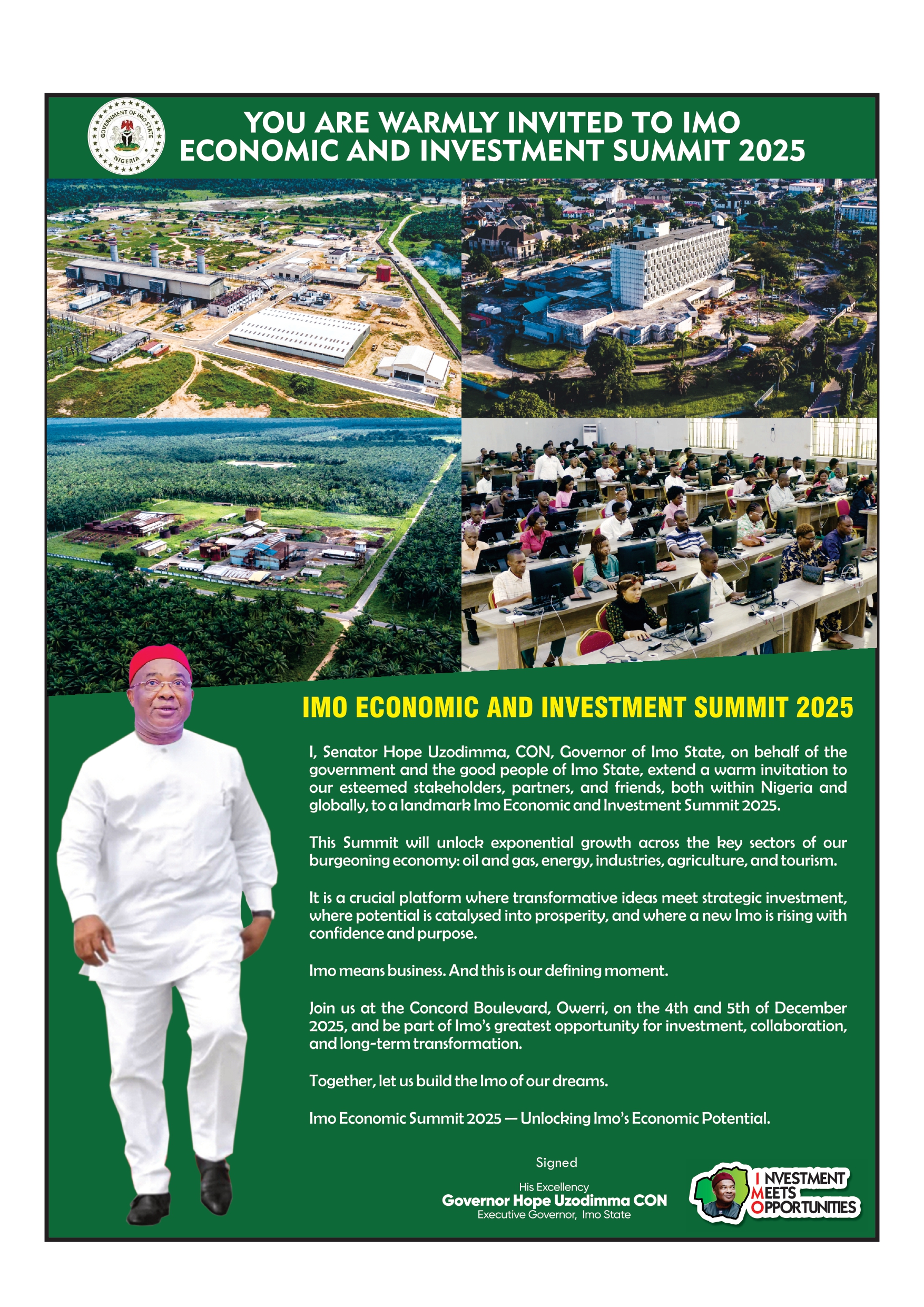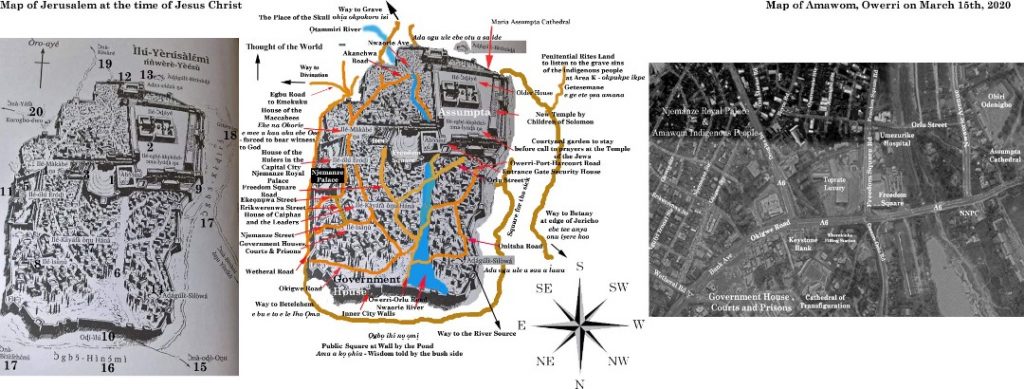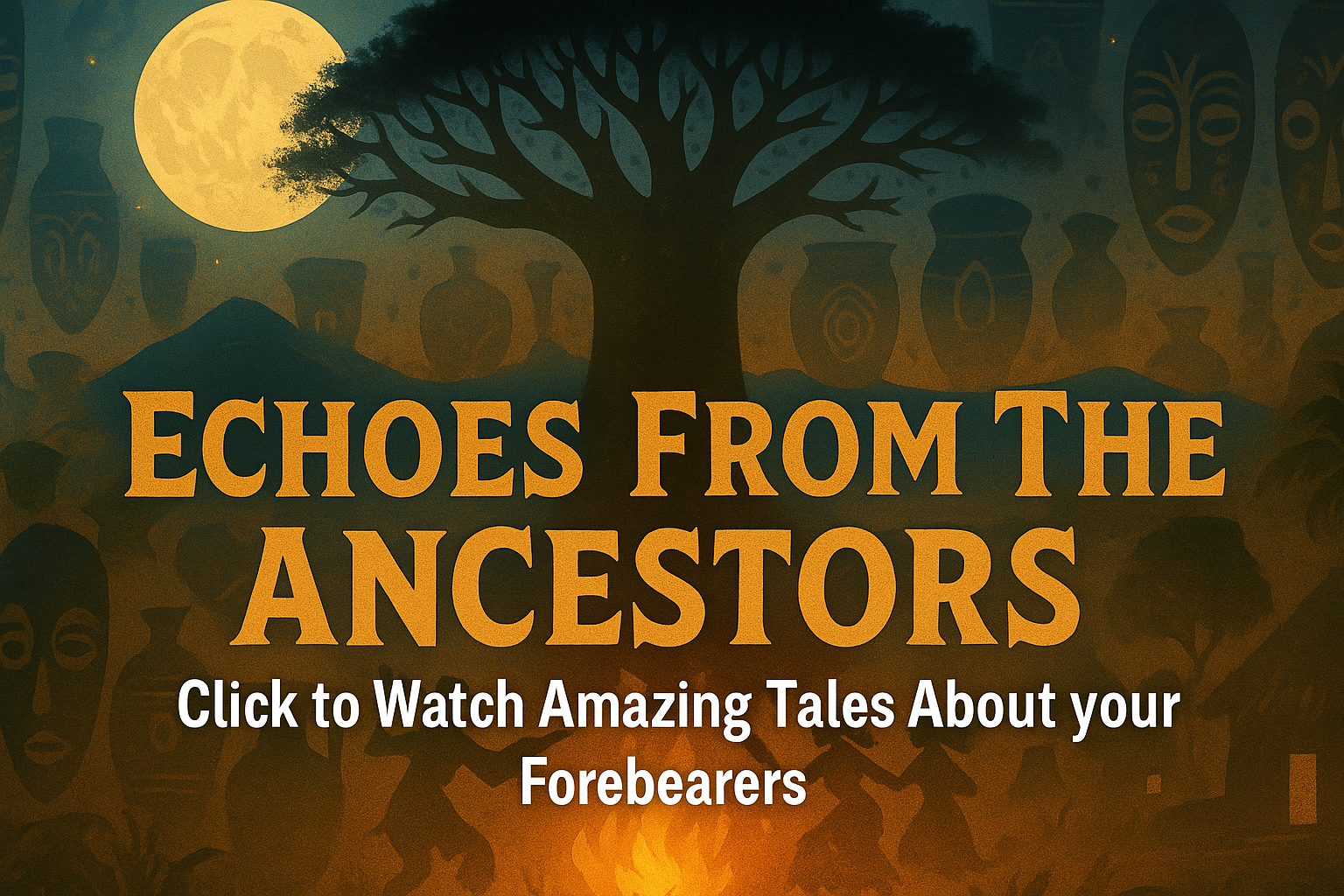Jesus of Owerri

By Academician Dr Philip C. Njemanze MD.
Author of the Book Series: Igbo Mediators of Yahweh Culture of Life Volumes 1-V.
My Easter Message to Imo People centres on ‘Jesus of Owerri’ and the discovery of the Temple of Solomon & Wailing Walls, Part 1, Igbo Mediators of Yahweh Culture of Life Volume V, which has its setting in Owerri, Imo State, Nigeria. The Temple of Solomon has been located covering the entire premises of Assumpta Cathedral Owerri and spreading across ten times the area over 2km x 2km, beginning at Freedom Square and ending westward at New Owerri next to Area K, stretching eastward to Concord Hotel area. In my books, I provide the first accurate account of the location of the Ancient City of Jerusalem (Igbo language: iyī érusala m, meaning ‘evil should not touch me’) and its outer walls as reconstructed by the structural engineer called prophet Nehemiah (Igbo language: na-aha ama uhu, meaning ‘arranged the settlements at the wall that is their sections for reconstruction’) who later became the governor of the Western Wall of Jerusalem living at Obinze (Igbo language: obi nze, meaning ‘quarters of the governor’). The Temple lies 9-11 meters down today. This assertion is supported by a map titled ‘Ìlú Yèrúsàlέmì ńǹwèrè Yèésú’ meaning ‘Capital City of Jerusalem at the Birth of Jesus Christ’, believed to have been made by anonymous Yoruba King from Dahomey modern Benin and held in the top secret British Archive. The city was surrounded by the inner Wailing Walls (Igbo language: ihi e ti eti, meaning ‘the wailing wall’; Owere dialect: uhu e ti eti, meaning ‘the wailing wall’) built around the Heart of the Capital City of Ancient Jerusalem which was the home of King David to this day called Amawọm (Igbo language: ama Owe m, meaning ‘the settlement of my Leader [King David]’). The walls enclosed the Royal Palace of King David (Igbo language: Di wụ edo, meaning ‘the man who is fair in complexion’), the Old Temple of King Solomon (Igbo language: isi e lo ama ana, meaning ‘the head that thinks wisely for the land’), in the present area of the traditional Royal Palace in Orukpu Njemanze (Igbo language: Ọ rị ukpu na-eje amana eze, meaning ‘it is sacred, the homestead of those who go to become the kings of the indigenous people’) the dynastic lineage of King David to this day. King David’s title was Owerri (Igbo language: Owe eri, meaning ‘leader from time immemorial’) who replaced King Saul (Igbo language: isi ala, meaning ‘head of state’) who was the Owelle (Igbo language: Owe e le, meaning ‘leader you look upto’) of Onitsha (Igbo language: anị otu ọcha, meaning ‘land of white sands’ as Niger river overflows its banks). The Prophet Samuel (Igbo language: saa mụ Eli, meaning ‘answer me the Most High as the petition from the mother for a child’) had come to Owerri to ask of the sons of Jesse (Igbo language: e lee nde ji isi eze, na-eje amana eze?, meaning ‘who are those who have the headship of the indigenous people that go to become kings’) and he chose David. The Map shows the Houses of the Chief Priest, Sanhedrin (Igbo language: isi na-ahụ e de arụana, meaning ‘the heads that look into and write the unlawful acts in the land’), Sadducee (Igbo language: isi e do udo ọsa, meaning ‘head advocates that keep peace among the people’) and Scribes (Igbo language: isi a kaara ibe ọsa, meaning ‘head advocate that bears witness for the people’), and Pharisee (Igbo language: efere ọsa, meaning ‘your worship of the people’) in the area of the High Courts and Government House in Owerri also called Ntuwu (Igbo language: ntụ iwu, meaning ‘where they make laws’). The city of Owerri and surrounding villages including Naze (Nazareth; Igbo language: ana e zere ụta ọha, meaning ‘land where He dodged the terror of the leaders’), Egbu (Igbo language: e gbuo, meaning ‘the Jews that shouted kill Him (Jesus)’), Awaka (Igbo language: a waa aka, meaning ‘the Jews that shouted that they should pierce His (Jesus) hands’), Uratta (Igbo language: uru a ta ụta, meaning ‘mourning for the wrongdoing – killing of Jesus’), Emekuku (Zion; Igbo langugage: e zuo ọnụ e meekọọ ukwu, meaning ‘gathering of a large crowd to associate at the Temple’), Ihitte Ọgada (Igbo language: ihi ete, e ti aga ada, meaning ‘because of grave sin he (John the Baptist called Ihijirika) shouted that they will fall’) were in the area traversed by the Sea of Galilee (Igbo language: ogo li elu, meaning ‘the districts on heights’) starting from river Okitankwo (Igbo language: akụ otu nkwọ, meaning ‘the riverside of Baptism’) nearby Nkwọemeke (Igbo language: the Baptism of Regeneration’) of John (Igbo language: jụọ aha nna, meaning ‘ask the father his name’). Those cities along the rivers are wrongly called Alaenyi (Igbo language: ala n’iyi, meaning ‘cities along the rivers’) collectively called ‘Sea of Galili’ in the Bible along which the Ministry of Jesus Christ took place. Jesus Christ was known before His birth by the locals as Emmanuel (Igbo language: Mmanụ Elu, meaning ‘Person from above’) because the prophet Isaiah (Igbo language: Ị saa Iho, meaning ‘if you answer the Divine Light’ he wrote about the rewards and consequences of nonresponse) from Okolochi (Igbo language: oko olu Chi, meaning ‘the youngman who is the voice of God’) also locally called Amadi Igwe (Igbo language: ama Ọ Dị Igwe, meaning ‘wisdom from the Eternal God’s throne’) refered in the Bible as Colossians (Igbo language: oko olu si Ose Enu, meaning ‘the voice from Almighty God in Heaven’). Prophet Isaiah declared to Owerri people that: Eri kwere nwa ikporo ga a mụ, meaning ‘the Ancient of Days promised a Child to be born by a Virgin’, at the place to this day called Erikwerenwa street in Amawọm that leads to the Palace of King David – na-eje amana eze. Emmnuel had worked as a sculptor with his father Joseph (Igbo language: onye o je e so a fụ, meaning ‘the person He follows to go out’) at the Market place on the street called Ekeoonuwa street (Igbo language: Eke Ọ nụ waa osisi, meaning ‘the Eke market place where He carved wood’). When Jesus started His ministry, there was a lot of uproar because of the miracles and teachings along river Nwaorie (Igbo language: Nwa Orie, meaning ‘Son of the Almighty God’) at Amakọhịa (Igbo language: ama a kọ ọhịa, meaning ‘wisdom that is told by the bushside’) and Akwakuma (Igbo language: akwa a kọ ama, meaning ‘wisdom told on the bridge’). Along this river Jesus met the fisherman Peter (Igbo language: pa atụ Orie, meaning ‘you have the instructions of God’ in his confession of Jesus as Son of God) who loaned Him his boat and then was ordered to spread the fishing net (Igbo language: ubu mmiri) and caught the miraculous fishes. This is why Owerri people do not fish at Nwa Orie river to this day. Peter abandoned the net with fishes there (Igbo language: e mee a ghara) and fell prostrate at Egbeada (Igbo language: e gbee daa, meaning ‘fell prostrate’). The area to this day is called Ubommiri. Peter had all his kindred follow Jesus and they are called Ụmụabali (Igbo language: ụmụ Aba Eli, meaning ‘community that followed the Spirit of the Most High’). The miracles of Jesus caused some elders in Owerri to say that it could be a reason for insurrection against the white Romans (Igbo language: oru ama enu, meaning ‘slave people from the northern settlements’) and repraisal attacks on the whole communities. They reasoned that was better that the Romans kill only Jesus. The elder Pharasee adviced (Igbo language: na-ejiri ibe a kọ, meaning ‘gossiped on his kinsman’ to the authorities) his kindred Ụmụọrọnjọ (Igbo language: Ụmụ rọrọ njọ, meaning ‘this community that came up with the conspiracy’) supported by Ụmụọdụ (Igbo language: Ụmụ ọdụ, meaning ‘community that gave the advice’), Ụmụeche (Igbo language: Ụmụ e che, meaning ‘community that guarded His tomb’) and Ụmụoyima (Igbo language: Ụmụ e nye ama, meaning ‘community that revealed where He was’) of the five kindreds that make up Owerri nchi ise (Igbo language: Owe eri na-echi isi Ị zara Eli, meaning ‘the leaders from time immemorial that crown the king of Israel’). At Jesus’s trial by the Chief Priest at the Temple of Solomon (Igbo language: isi ụlọ Ama Enu, meaning ‘main building of the High Church’), then at the area of the Government House Chapel Owerri which was the office of the resident head Pilate (Igbo language: pa ọlụ a tụ ọsa, meaning ‘has the responsibility of directing the people’) and then the governor Herod (Igbo language: a họọrọ dị isi, meaning ‘the chosen one at the top’) at governor’s office. The Jews called Egbu (Igbo language: e gbuo, meaning ‘crucify Him’) and Awaka (Igbo language: a waa aka, meaning ‘pierce His hands’) shouted for Jesus to be crucified at Ugwu Ekwema Arugo (Igbo language: ugwu ekwe ọma arụ ogo, meaning ‘hill at the skull shrine of the abomination of the district’). A Roman army conscript from Awaka shut an arrow at his side (Igbo language: ọ gba ube Nwa Chukwu, meaning ‘shut an arrow at the Son of God’) blood and water came out and the people exclaimed as the water dropped into the nearby river Ọtamiri (Igbo language: Ọ taa mmiri, meaning ‘blood and water dropped’). Jesus body was taken for embalment by a pharasee (Igbo language: onye a wụ Chi ori ojii, meaning ‘the person that applied black embalment ointment on God’) and his friend (Igbo language: Chi e do, meaning ‘he preserved the body of God’), both were local embalmers from the village of embalmers called Orjii (Igbo language: ori ojii, meaning ‘the black embalment ointment’). Jesus was buried at the Place of the Skull (Igbo language: ọhịa okpokoro isi) on Golgotha (Igbo language: ogologo otu, meaning ‘long bank of the river’) at the present area of St Mulumba Catholic Church Owerri along Wetheral Road. Three days later He rose along with the people called Ekenaokorie (Igbo language: e kee oko Orie, meaning ‘the regenerated men of God’) who died 100 years earlier during the Maccabean revolt and were called Maccabees (Igbo language: e mee aka ebe Ose, meaning ‘bore witness to Almighty God’). The events of the Death of Jesus in Owerri are commomerated yearly as Oru Owerre (Igbo language: uru Owe Eri, meaning ‘the sorrow of the leaders from time immemorial’) with roasted yam and fresh palm oil (Igbo language Object form: ahụhụ ji a kwaa mmanụ elu, meaning ‘roasted yam with fresh oil’; subject expression: ahụhụ e ji kwaa Mmanụ Elu, meaning ‘the suffering which was used to wake the Person from Heaven’). After 3 days there would be clearing of the path to the burial site called Ọbụbọ ụzọ (Igbo language subject expression: Ọ bụbọ a zọ, meaning ‘the killing that brought about salvation’). All communities and places bear the names given with the events of the Life Jesus of Owerri as a mark of pennitential rites [Ephesians 3:14-15]. You can learn more about the mystery of ‘Jesus of Owerri’ in the book series: Igbo Mediatorsof Yahweh Culture of Life Volumes 1-V on Amazon and Writers Republic
https://www.writersrepublic.com/bookshop-preview/9781637285671 .



